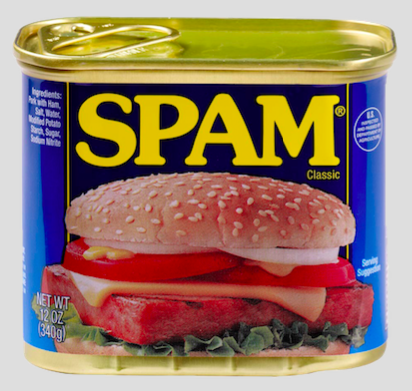Hawaii’s Spam Scam

Spam, pictured above, is food… well, nominally speaking. It was invented in 1937, per Wikipedia, in an effort “to increase the sale of pork shoulder which was not a very popular cut.” It still wasn’t very popular, though — it’s more of a food of necessity than anything else. While canned, pre-cooked surplus pig meat may not be all that appetizing, it keeps well. According to Hormel’s official website (they make Spam), “products packaged in cans [like Spam is] are safe to use indefinitely, as long as the can seal remains intact, unbroken and securely attached to a can that has been well maintained.”
That’s not very appetizing-sounding — and it’s not something you’d usually steal. And yet, Spam theft is real — in Hawaii at least. If you visit a grocer there, you may find it kept under lock and key.
Hawaii’s odd relationship with Spam has its roots in World War II. American views of the Japanese were very negative, even to the point of Americans taking action against other Americans due to Japan-driven fears. The best-known example came in February of 1942, when President Franklin D. Roosevelt issued Executive Order 9066, mandating that Japanese-Americans in military zones be relocated to internment camps. But that wasn’t the only example. As Nat Geo reports, in the 1930s, “the Japanese government arranged for many of Hawai’i’s Japanese fishermen to attend fishing schools in Japan, [and] there were concerns that the fishermen were being interrogated by Japanese Navy officials on hydrographic conditions in Hawai’i.”
Ultimately, the American government severely restricted off-shore fishing in Hawaii. That meant less fish, and less fish meant a need for an alternative food source. What doesn’t spoil and can be transported, relatively easily, to a group of islands well off the coast of California? Spam. The government sent tons of the mystery meat to the future 50th state and since then, Spam has been quite popular in Hawaii. Today, it’s used in some regional delicacies like Spam musubi (basically sushi, but with Spam instead of raw fish) and appears in menu items in both Burger King and McDonald’s in the state.
But in 2017, Hawaiian Spam started getting locked up.
As the Today Show explained, grocers across the state were reporting a spate of Spam thefts. And we aren’t talking about a can or two. Thieves were stealing cases of the stuff at a time, per Grub Street: “At a Safeway on Oahu, a customer spotted a man who grabbed eight cases of Spam and made a beeline for the exit. In another instance, three women at a Longs drugstore filled shopping carts with 18 cases of Spam and bolted — but were thwarted by a customer no doubt compelled to defend Hawaii’s Spam supply.”
Why bother? Hawaiian law changed. Before the Spam heists began, stealing items worth $350 or more was considered a felony — in other words, stealing a few cases of Spam was a major crime. When Hawaii upped the threshold to $750, it became a lot less risky to take the canned meat and run. And that’s exactly what happened. Authorities surmised that the Spam bandits were stealing the canned meat to get money to buy drugs. The theft itself was now a misdemeanor and, unless you were caught in the act, it was hard to figure out who did it — it’s nearly impossible to track stolen Spam. And perhaps most importantly, the product could pay dividends immediately and then long-term as well. The market for Spam in Hawaii was robust, allowing for some quick sales, but the product has an infinite shelf-life, so if one couldn’t resell it right away, well, there’s really no rush — it’s not as if the stolen Spam was going to go bad anytime soon.
Thankfully for grocers and fans of Spam alike, this spate of thefts have decreased. While some Hawaiian vendors still keep the canned meat under lock and key (here’s an example from August 2018), it has become increasingly less common.
Bonus fact: Want to learn a lot more about Spam? You can, for free — if you live near Austin, Minnesota, about a two-hour drive south of Minneapolis/St. Paul. How? That’s where the world’s only Spam Museum is. It features a wall of more than 3,000 cans of Spam, a mock assembly line where visitors can pretend to can Spam themselves, and a team of guides known as “Spambassadors.” One thing it doesn’t have is a vegetarian version of Spam — because Hormel has never made it and never will. Or will they? No, confirmed one Spambassador, to Roadside America: “Some people do ask that question. I tell them it’s un-American.”
From the Archives: They Blue It: Why some Hawaiian stop signs are blue.
